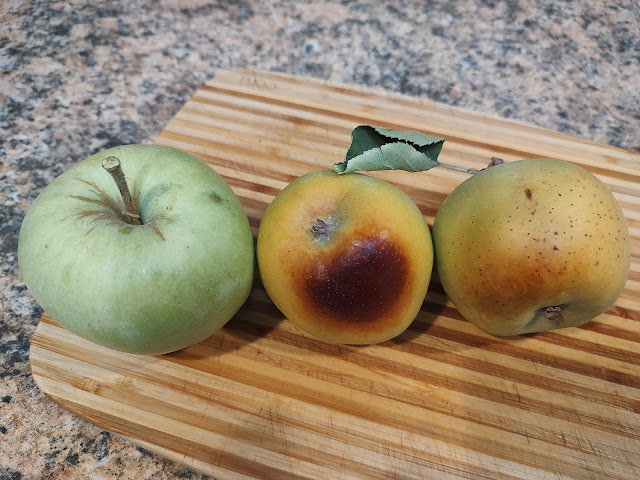
Fruit can develop ugly brown spots even if not exposed to full afternoon sun

|
| These Granny Smith apples are all off the same tree. The apple on the left grew on the north side of the tree. (Photo: Debbie Arrington) |
Another side effect of a red-hot July: Sunburned apples.
Although they need full sun to grow and bear fruit, apple trees can get too much sun -- and absorb too much heat, leading to sunburned apples. Those apples develop dark brown splotches and other scarring.
It’s a problem in Sacramento as well as Washington, the Apple State. No state grows more apples than Washington, which is why that state has devoted a lot of resources researching apple problems.
Sunburn is a major issue for Washington growers, according to Washington State University.
“Growers often lose more than 10% of their apples to sunburn unless they have used some means of protecting their fruit from sunburn damage,” says the university’s Crop Protection Guide. “Apple fruit are susceptible to sunburn because they have a much higher thermal mass (the ability of a material to absorb and store heat energy) than leaves and are not able to dissipate this heat as effectively as leaves.”
The apples hanging on the tree can absorb more heat than their tree’s leaves. In fact, fruit temperature can be 20 to 30 degrees higher than the surrounding air temperature, say the researchers. It’s that high heat – and not necessarily direct sun – that can cause sunburn.
Those brown splotches – called sunburn browning – are caused by a combination of the sun’s UV rays and high temperatures. They appear when the fruit surface temperature has reached 115 to 120 degrees F. Fruit nearing harvest is most susceptible.
If the fruit temperature tops 125 degrees – even for only 10 minutes – cells start to die in the fruit, resulting in sunburn necrosis. That results in black or dark brown lesions, regardless if the fruit was exposed to direct sunlight. “This type of sunburn can be exacerbated by low humidity,” say the WSU researchers.
Sunburned apples are edible; the damage is mostly cosmetic and can be trimmed off. But WSU researchers found sunburn also changed the apple’s chemistry and taste. Sunburned apples tend to be firmer, have a higher sugar content and less acid. They may taste a little sweeter, but the lack of acidity also made them taste bland – not a good characteristic, especially for pie apples.
WSU recommended providing a little filtered shade to apple trees that tended to produce sunburned fruit, especially on their south- and/or west-facing sides. That shade could be as simple as protective netting.
“Protective netting may be deployed above the orchard canopy or draped directly over apple trees and has proven to be effective at reducing sunburn incidence, as well as conferring other benefits such as protecting against hail damage, reducing wind stress, and potentially excluding some invasive insect pests and birds,” say the researchers.
To protect against sunburn, Washington growers depend on “evaporative cooling” – basically, misting trees with extra water to cool them down. It’s expensive – and impractical for backyard apple growers.
And yes, there is sunscreen for apples. Growers may spray products that put a thin coat of clay particles, calcium carbonate or UV-blocking wax over the fruit. But those products tend to leave a residue film over apples that can be hard to wash off.
For more on apples and sunburn: http://cpg.treefruit.wsu.edu/environmental-fruit-protectants/apple-sunburn/ .
And for how to protect trees and shrubs from sunburn: http://ipm.ucanr.edu/PMG/GARDEN/ENVIRON/sunburn.html .
Comments
0 comments have been posted.Sacramento Digs Gardening to your inbox.
Food in My Back Yard Series
May 6: Maintain soil moisture with mulch for garden success
April 29: What's (already) wrong with my tomato plants?
April 22: Should you stock up on fertilizer? (Yes!)
April 15: Grow culinary herbs in containers
April 8: When to plant summer vegetables
April 1: Don't be fooled by these garden myths
March 25: Fertilizer tips: How to 'feed' your vegetables for healthy growth
March 18: Time to give vegetable seedlings some more space
March 11: Ways to win the fight against weeds
March 4: Potatoes from the garden
Feb. 25: Plant a fruit tree now -- for later
Feb. 18: How to squeeze more food into less space
Feb. 11: When to plant? Consider staggering your transplants
Feb. 4: Starting in seed starting
Sites We Like
Garden Checklist for week of May 4
Enjoy this spring weather – and get gardening!
* Plant, plant, plant! It’s prime planting season in the Sacramento area. Time to set out those tomato transplants along with peppers and eggplants. Pinch off any flowers on new transplants to make them concentrate on establishing roots instead of setting premature fruit.
* Direct-seed melons, cucumbers, summer squash, corn, radishes, pumpkins and annual herbs such as basil.
* Harvest cabbage, lettuce, peas and green onions.
* In the flower garden, direct-seed sunflowers, cosmos, salvia, zinnias, marigolds, celosia and asters. (You also can transplant seedlings for many of the same flowers.)
* Plant dahlia tubers. Other perennials to set out include verbena, coreopsis, coneflower and astilbe.
* Transplant petunias, marigolds and perennial flowers such as astilbe, columbine, coneflowers, coreopsis, dahlias, rudbeckia and verbena.
* Keep an eye out for slugs, snails, earwigs and aphids that want to dine on tender new growth.
* Feed summer bloomers with a balanced fertilizer.
* For continued bloom, cut off spent flowers on roses as well as other flowering plants.
* Add mulch to the garden to maintain moisture. Mulch also cuts down on weeds. But don’t let it mound around the stems or trunks of trees or shrubs. Leave about a 6-inch to 1-foot circle to avoid crown rot or other problems.